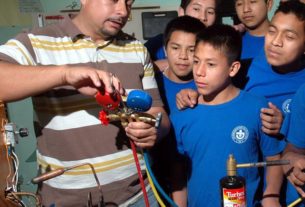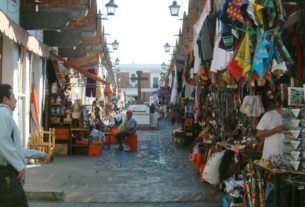A Voice from Oaxaca
First-time travelers to Oaxaca, as well as return visitors and snowbirds, can all help to improve the financial lot of many struggling residents, aside from simply visiting the city and spending.
It’s a fact that tourism has indeed returned to the central valleys of the state of Oaxaca. But as a result of the US economic crisis in 2008, so have many Oaxacans: Oaxacan immigrants, documented and otherwise, had previously been eking out a modest existence north of the border, often wiring money back to their motherland on a regular basis to help out parents, children and extended family members in need. With fewer available jobs, the people flow has now been reversed. Oaxacans are coming back to their native soil. The economic implications are twofold:
- There are now more Oaxacans vying for work, which continues to be a scarce commodity.
- With fewer Oaxacans working in the US, less money is being sent home.
Many hotel and B & B guests arrive with two suitcases… one filled with their clothes and toiletries, which fits snuggly inside a larger one. The latter is used for the flight back home, to pack up purchases such as rugs and other textiles, black pottery and a variety of different ceramic pieces, alebrijes, and more traditional fine art. That larger suitcase need not be brought down empty. Those who have already been sensitized to Oaxaca’s economic plight sometimes ask what they can bring to leave behind, filling their second piece of luggage with used clothing, pencils, pens and other school supplies, T – shirts and caps with logos of their local sports teams, and much more. And then there are the travelers with young children who recognize that by the time the next summer arrives in their hometowns, the kids will have outgrown virtually everything they’ve brought down for them to wear. Here in Oaxaca they find new homes for shoes, shorts, jeans, dresses and shirts.
Within less than an hour’s drive from downtown Oaxaca, townspeople in marginal communities subsist on tortillas, beans and rice, with meat and poultry reserved for only the most special of occasion. Medical clinics and dental facilities are often stocked with inadequate equipment, instruments and supplies, and schools lack books. Even the brightest students and those with the most drive and desire are denied the opportunity to complete their secondary education because the cost of transportation to attend high school in the larger centers is prohibitive relative to the means of their families.
Every visitor to the city of Oaxaca has the potential to make a significant contribution to the economic amelioration of residents of towns and villages in the central valleys, apart from buying handicrafts and art.
We all have much more clothing than we need. Just look in your closet or in that chest of drawers in the basement. You might even find your daughter’s old pair of eyeglasses from two prescriptions ago, useless to you but invaluable to a downtown optometrist with ties to villages with children whose parents have no money to buy glasses. Dig out that gift from your mother-in-law — the sweater that’s far too gaudy, or theT-shirt she brought for you on her trip to Turkey three years ago, still in the plastic wrapper. Do you really think that as you get older it’s realistic for you to start exercising as you did before, and that you’ll actually lose that paunch and fit into those size 32 jeans? How long do you think it will take for those shirts with Saturday Night Fever collars to come back into style? Here in parts of Oaxaca they’ve never gone out of style.
The reluctance to personally distribute what you can no longer use is understandable. Certainly filling up a couple of green garbage bags in the course of your annual spring cleaning and then taking them to the local clothing drop box is easier, and the anonymity which comes with it is somehow preferable. It precludes any possibility of that feeling of discomfort that often results from directly confronting differences in economic status. But for those Oaxacans in need, all contributions are welcomed and tremendously appreciated.
Bring whatever you can. And if you’re not a packrat, there are other ways you can help:
- Ask your neighbors and relatives. They’ll be happy to use the new-found closet space.
- If you’re a medical or dental professional, search the shelves in your storage cabinet for instruments that have become obsolete for your state-of-the-art practice.
- If you’re a manufacturer with over-runs, or a wholesaler, jobber or retailer with stock that you just can’t move, consider packing up whatever will fit into that extra suitcase.
Not knowing what to do with it once you land in Oaxaca is certainly a legitimate, but not insurmountable concern. Again, there are several options:
- The manager of your hotel or B & B might assist in distributing clothing to members of his cleaning staff who in all likelihood are of extremely modest means, or might suggest that some items be given to one of several local charities such as Estancia Fraternidad or Casa de La Mujer.
- If you plan to tour some of the craft villages, your tour guide or driver might be able to assist you, although residents of the more popular and consequently successful towns such as Teotitlán del Valle and San Martín Tilcajete might not be the ones to whom your generosity should be directed. Consider spending part of a day getting away from the more traditional tourist sights, perhaps venturing into the hills and tiny communities, the inhabitants of which are predominantly campesinos. This affords an opportunity to see first hand the modest lifestyles of most Oaxacans and experience the “real” Mexico. Your chauffeur should be happy to accommodate, and you can distribute goods as and to whom you wish.
- Drop your donation by the Oaxaca Lending Library on Calle Pino Suarez. Its volunteers are involved in a number of outreach projects.
- Contact me and I’d be honored to come by your accommodations, pick up whatever you have, and ensure that it goes to good use.
Regular visitors to the city and the numerous returning snowbirds are afforded an even better and easier opportunity to help. Consider leaving your entire Oaxaca wardrobe and all your toiletries in Oaxaca, permanently. Remember, you still have more than enough to wear at home, and already having bathroom items awaiting you upon your return to Oaxaca can be quite convenient, especially in light of airline restrictions regarding sprays and bottles.
Pack it all up in a few boxes, or better yet buy an inexpensive chest of drawers to store your belongings, like I did about a dozen years ago when I was a frequent visitor to the city. Toss in a few bars of soap or pieces of cedar to keep it all fresh smelling. Then impose upon one of your Oaxacan or expat friends to keep it for you in a closet, corner or storage room. For your subsequent visits to the city all you’ll be bringing down will be two suitcases filled with treasures for those in need. And remember, with all that Oaxaca has to offer shoppers, craft collectors and art aficionados, there’s never a risk that you’ll return north with empty luggage.


